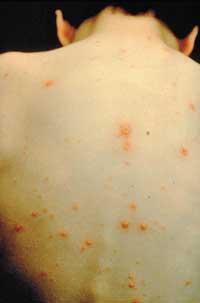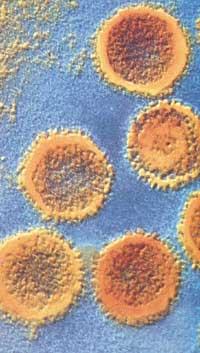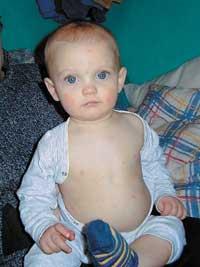Chickenpox

At first, after contact with the virus, the incubation period comes, followed by discomfort and when the exanthema (characteristic phase of the disease) appears we are able to diagnose. When skin lesions heal, barbarism usually disappears spontaneously.
But as in other infections caused by herpes family viruses, the disease-causing virus is protected in a specific place (nerve ganglia) where it remains ‘in the lethargy’ for a lifetime. In certain circumstances, especially when natural defenses against infection decrease, the virus recovers and causes herpes zoster.
Chickenpox is a benign disease that cures itself in healthy children. But do not forget that the disease is usually more serious in people with reduced defenses (immunoguchados), newborns, adolescents and adults.
What and how does chickenpox create?
Chickenpox is a virus in the herpes virus family, the Varicella zoster virus (VZV). People are the only VZV deposit. The process is highly contagious: 90% of sensitive people who have had a relationship with an infected person are victims of barbarism. Sensitive people do, but not protected people. And contact should be close, because outside, that is, outside infected people, barely survives.
How can we know that a child has chickenpox?
The first symptoms appear 14 days after the relationship with the virus (after the incubation phase). The first 3 days appear podromes: fever (38-39ºC), discomfort, lack of appetite, sore throat and cough; nothing special, symptoms similar to other pathologies. These discomfort are more severe the more the child is raised (in young children they can go almost unnoticed).

After these first symptoms, one or two days later, an exanthema appears on the skin that produces an intense itching. The first skin lesions appear on the scalp and spread rapidly to the trunk, eventually reaching the extremities. The average number of vesicles or pusles is very variable (usually 200-300), although in more severe cases up to 500 beans or more may appear.
The evolution of injuries is very special. Initially they are maculas (flat, relatively small reddish lesions) that swell gradually (in this phase they are called papules) and then become blisters or pusles filled with a transparent liquid (vesicles). Twenty-four hours later, due to inflammation, the inner fluid is disturbed. In this phase the vesicles break easily and, once dried, the crust or crust appears. It is very normal to observe at the same time lesions in different evolutionary stages.
Normally the exanthema disappears spontaneously and completely. In the patient with good defenses against infection no new lesions appear from day 4 and crusts begin to form on day 6. If by itching the patient pulls on the lesions, these lesions can be painful with other bacteria, in which case stains can appear, especially on the face.
Diagnosis: how can I say that it is a barbarity?
Diagnosis of chickenpox is made with the patient's medical history and the examination of lesions, but the presence of similar cases in the environment (school, neighborhood, family) is of great help to confirm the diagnosis.
If the usual exanthema appears, with lesions in different evolutionary stages and with great itching, and has been in contact with a varicellad patient in previous days, this data is sufficient to establish a clinical diagnosis.
In special situations it is usually necessary to use laboratory techniques (see if virus is grown in the injured fluid or demonstrate the response of antibodies in the patient's serum). But usually these tests are not done.
What is the treatment?
Hygiene is very important so that there are no complications: it is advisable to bathe with dry soaps and cut the nails so that they do not bother in the lesions and these do not damage. To reduce itching you can use talc powder and the like.
What consequences can chickenpox have?

The usual prognosis for chickenpox is good, as it is a limited disease that cures itself
The most common problem is herpes zoster, as we have seen before. The risk of other complications is low in healthy children, but not negligible in infants, adolescents, adults or people with decreased defenses.
Skin problems Vesicles can be diseased by bacteria such as Staphylococcus aureus or Streptococcus pyogenes. In these cases, chickenpox may leave permanent spots. Beware of itching, don't do it on finger injuries.

Central Nervous System Problems Cerebellum ataxia occurs in 1 out of 4,000 cases and is usually fully recovered. For its part, varicella encephalitis appears in 1.7 out of every 100,000 cases in children up to 14 years old. In the worst cases it can cause death.
Respiratory problems Pneumonia is not common in children, at least if they are not immunogusted children, but it is the most common serious complication in adults, especially among smokers: a few days after the rash cough, difficulty breathing, fever and chest pain appear. It heals well with proper treatment.
Forms of chickenpox contamination By oral dropletsSwallowing the droplets that an infected person throws into the mouth when talking or coughing (this is the most common way to spread it). Even before the onset of exanthema (4 days before), the patient is able to become infected to anyone, and this contagion capacity persists up to 6 days after the onset of the first skin lesion.Contact with superficial vesicles of the patientThese patients are contagious a couple of days before the onset of lesions, until all skin lesions are covered with crust or crust (usually 4-5 days are needed).Transmission during pregnancy The infected mother can transmit barbarism to the fetus. Of all children born to pregnant women who have passed chickenpox, 2% develop congenital chickenpox syndrome. |
How can barbarism be avoided? The chances of eradicating the disease are three: chickenpox vaccine, passive immunoprophylaxis and camionprophylaxis. Let's see it one by one, even briefly. Chickenpox vaccineOKA is a vaccine of live attenuated viruses from slags. The immune capacity of the vaccine is very high, so it provides immunity to most healthy people. The vaccine is 75-95% effective against any form of infection. The duration of immunity is long and has few side effects. It is applied subcutaneously and in a single dose before age 12. From the age of 13, as well as in immunogenic patients, the administration of two doses with an interval of 4-8 weeks is recommended.Passive immunoprophylaxisIt is about giving antibodies that protect us against infection. In Spain there is still no specific immunoglobulin against Varicella zoster for the intramuscular.Chemoprophylaxis involves giving antivirus medications to a patient who has had contact with a person affected by chickenpox, in order to prevent or modify the disease. Sensitive people who may be severely affected by the disease may also be treated. |





